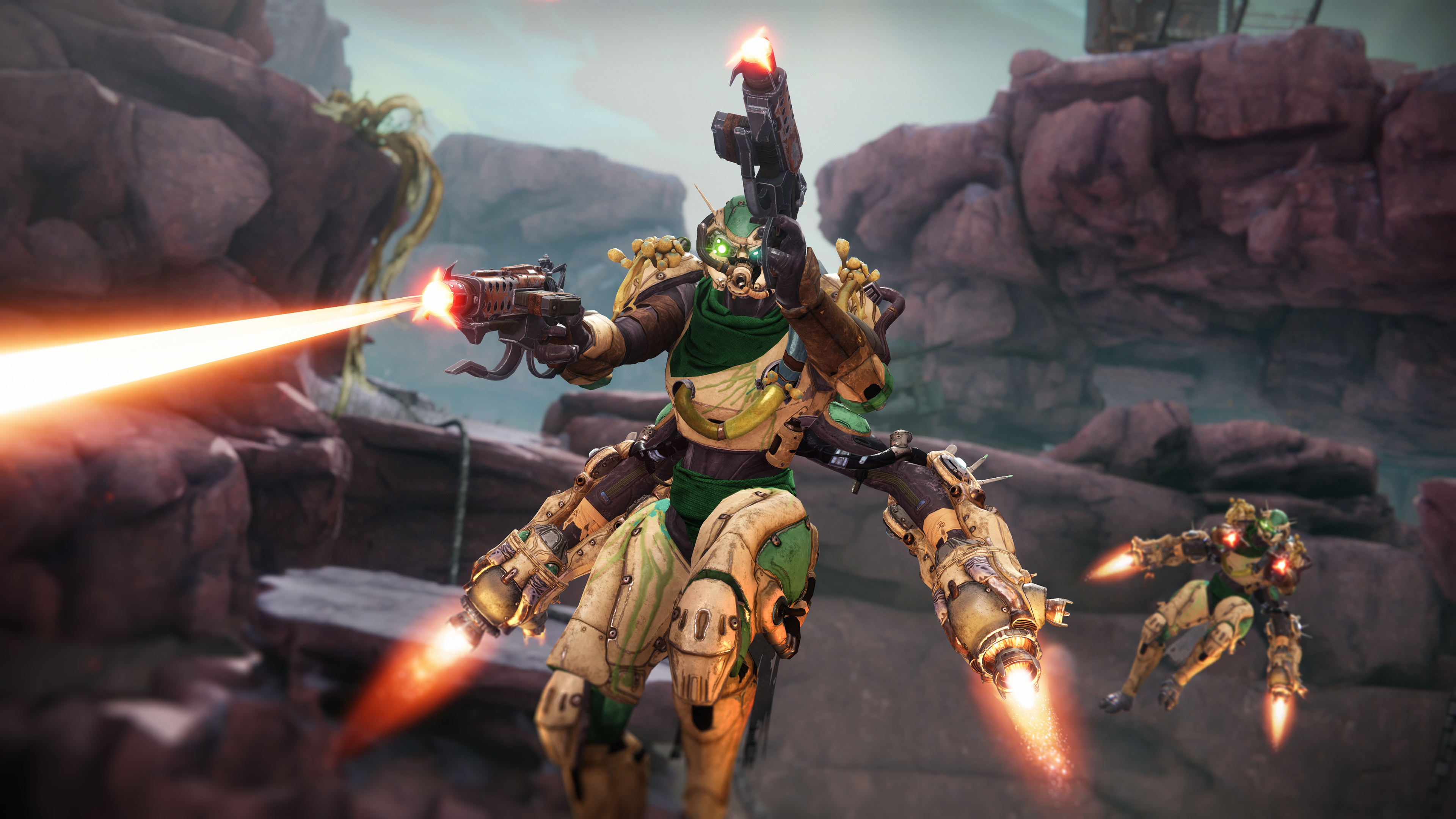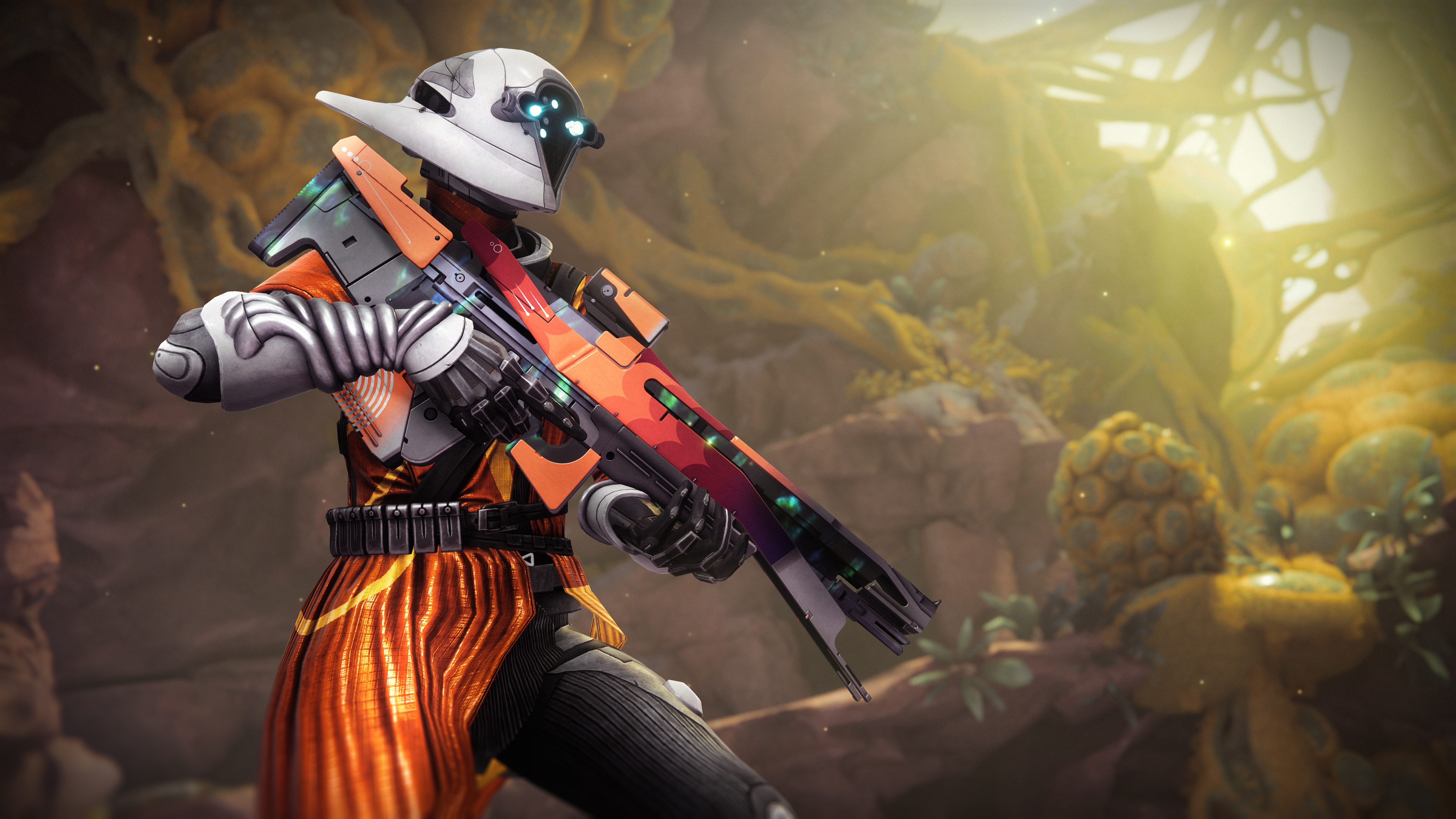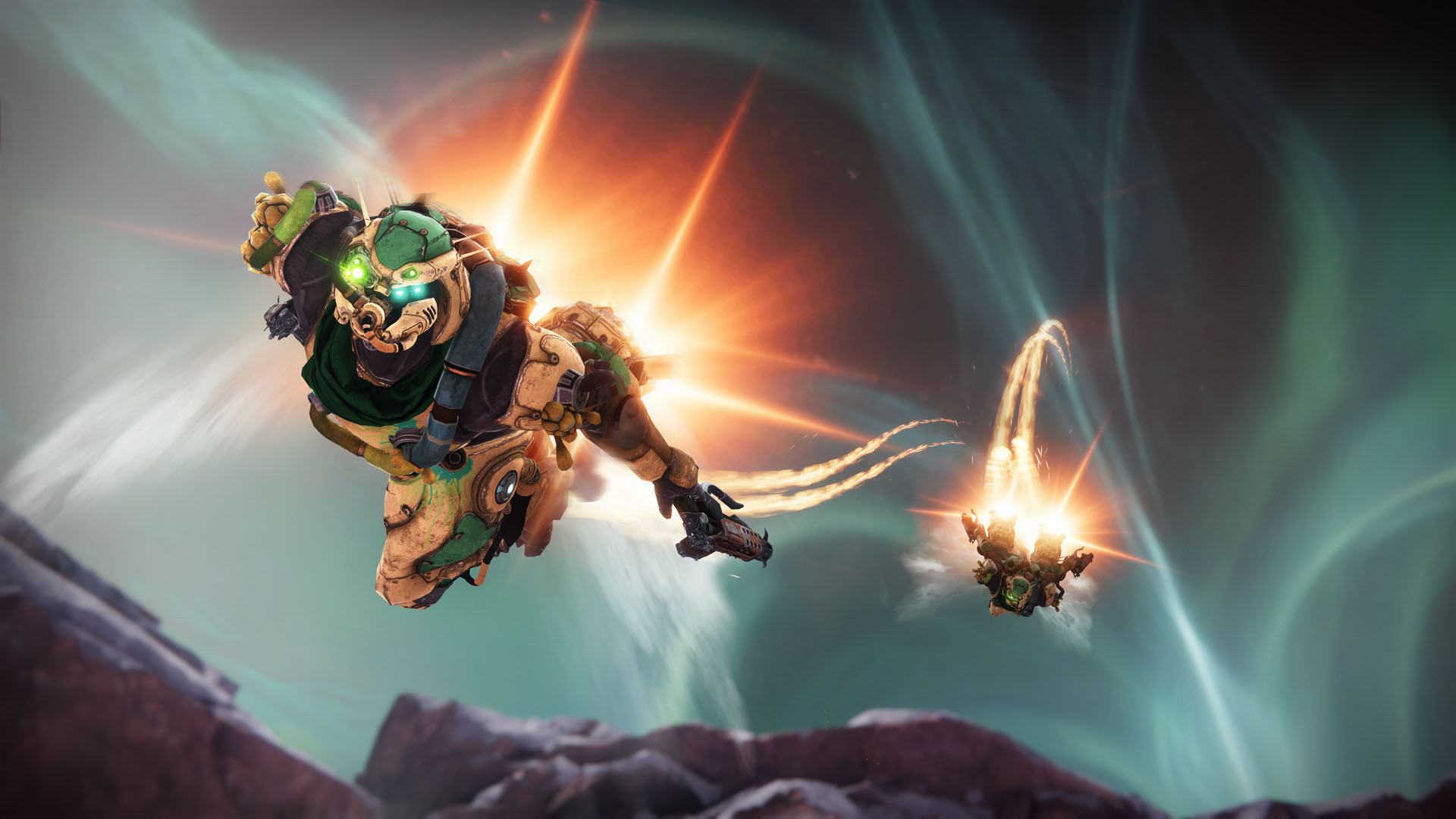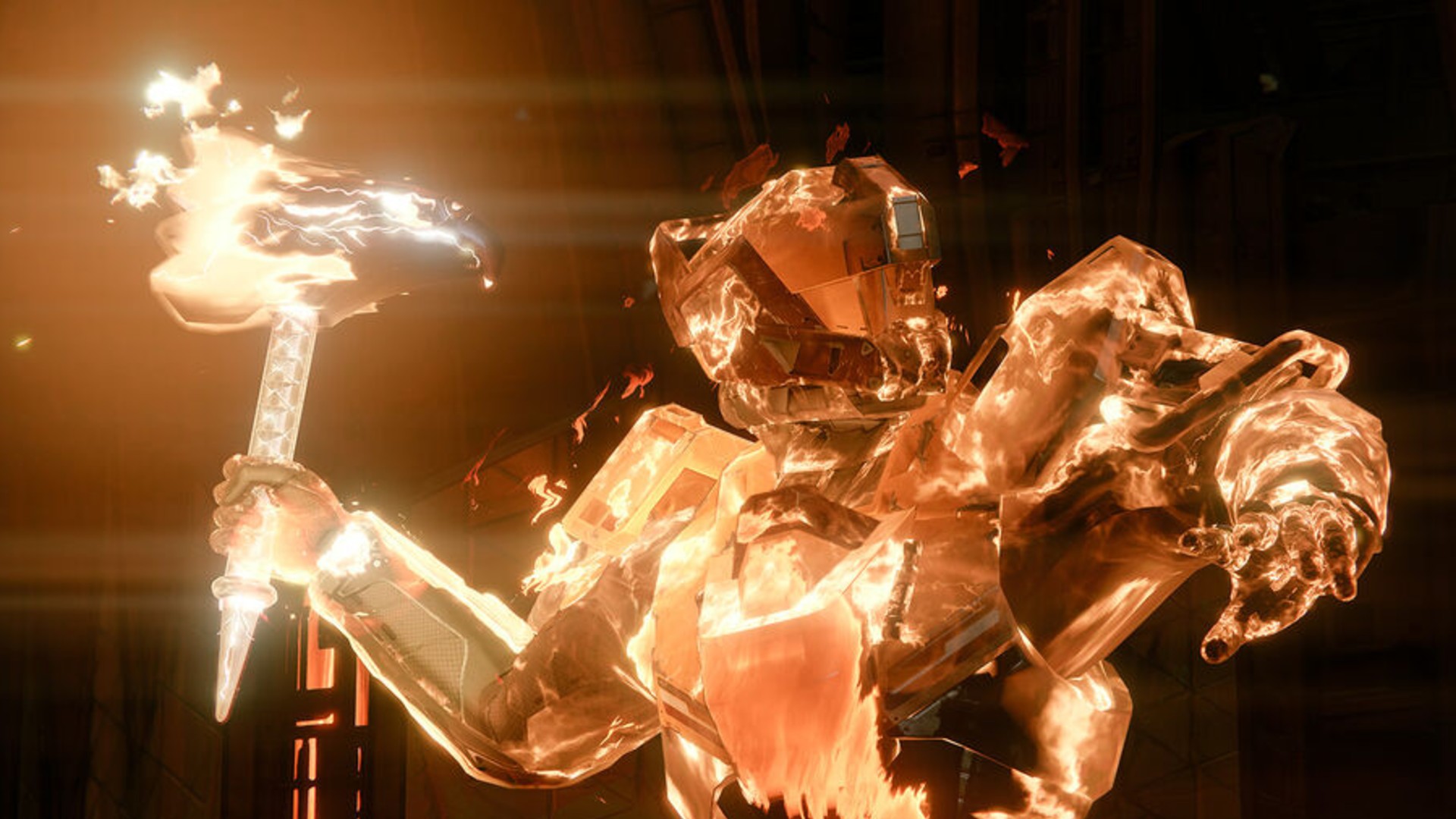
Tyson Green talks about being 'the fun police', creating meaningful rewards for solo players, and making a love letter to Super Metroid.
It’s hard to think of a time in the decade since Destiny launched when the next expansion wasn’t make or break. As the first major release since last year’s The Final Shape, which did the improbable job of landing the game’s sprawling narrative successfully, this year’s The Edge of Fate expansion has the unenviable job of kickstarting a whole new saga. It also has to reverse historically low player counts and introduce a raft of major systemic changes at a time when morale at Bungie is reportedly bleak in the wake of the Marathon plagiarism debacle.

Looking for more on Destiny 2’s new expansion? We’ve played a bunch of missions on the new location of Kepler, and seen The Edge of Fate’s new exotic weapons and armor.
A couple of weeks ago I travelled to Bungie’s Bellevue, Washington studio to play The Edge of Fate and speak with some of the most senior developers on the team. You can read our hands-on impressions, and check out six of the new exotic items coming in the expansion—one of which has already had to be nerfed twice. Below you’ll find the entirety of my conversation with Tyson Green, Destiny 2’s game director, and Robbie Stevens, assistant game director.
We touched on a wide range of topics, from why Green hates having to be ‘the fun police’, to the lack of vault space going into a major loot system shake up, Super Metroid as a major influence of The Edge of Fate and even whether we’ll ever get akimbo weapons.
Tim Clark, PC Gamer: Edge of Fate brings a raft of big systemic and quality of life changes. Do you think that’s going to be enough in a world where you’re looking to bring people back post-Final Shape, and where player concurrency is lower than I’m sure you’d like it?
Tyson Green: We’ve seen that when we have a release that is a compelling mix of campaign and story, but also [has] free systemic changes… then players take them together as a full product. The best example of this was Witch Queen, which was a great release, and came along with a set of free subclass updates—void 3.0—and players really embraced those as a cohesive product, even though void 3.0 was free to all players.
So we think that making the core game of Destiny stronger is a tide that raises all boats. It makes for a better expansion experience, and a better free experience. So I think that’s there’s strength in the model that we’re trying to move into now.
But without any major addition to the existing subclasses or a new damage element, don’t you worry that the buildcrafting side of things may stagnate?
Tyson Green: One of the big changes in Edge of Fate for people who are into buildcrafting is the armor set bonuses. They are very punchy, almost exotic-level, build enablers. My favorite one that I was playing with recently is the set bonus that makes your kinetic weapons break shields more easily, and then does disruptive explosions when you either break a shield or take down a powerful combatant.
I was like: ‘Oh my god, I need to figure out which kinetic weapon do I want to use to get into this space?’ So we’re going to be able to explore more and more with new armor sets, and really make them an active part of your build in ways that [armor] hasn’t been to date, because [legendary gear] lacked that element of build craft contribution. They’ve also suffered because of the way the stats used to work.
Robbie Stevens: So much of the core foundation is changing with stats on armor. The buildcraft space is expanding in a way that is going to provide a bunch of different opportunities, and [these stats] do directly affect abilities, as well.
We’ve got to provide more opportunity to make the actual loot chase of armor and weapons feel better, and make it more fun with the gear tiering systems. As with changes like the 3.0 subclasses, we know that in the future we’re going to do updates. It’s just that this first go around is a larger change to more of the game.
Can you tell me what you might be prioritizing in terms of future changes? The Darkness subclass each only having one super ability seems like an obvious gap to fill.
Green: Yeah, the dark subclasses having a smaller selection of gameplans is definitely something that’s on the team’s radar. As far as prioritization goes, a thing that we’re looking at in upcoming releases is a lot of streamlining and usability—like, getting more of the subclass content into players’ hands in a systemic, sustainable fashion. But we’re never going to be done with the subclasses. We don’t stop development on them. We look at them as opportunities arise and as the team has the ability to add to them.
It’s this problem that we haven’t been able to shake. Storage may be cheap on the server, but it’s not cheap on the client.
Tyson Green
An obvious question, given you’re bringing in entirely new types of weapons and armor, is why we’re not getting any extra vault space? It seems like such an obvious pressure point. I know that Bungie has said changes are coming in a future expansion, but could we not have had 100 slots as a Band Aid?
Green: This is one where we understand the pressure. It’s this development problem that we haven’t been able to shake with Destiny. That storage space may be cheap on the server, but it’s not cheap on the client, and that’s unfortunately the problem that we run into.
So we have to figure out a solution for this. And we’re working on this one because we know that adding a bunch of armor sets, and tiers of weapons, into the game is going to create a lot more keepsakes—things that people want available for their build crafting options in the future. So we’re definitely aware of this one, and we’re working on solutions.
You’ve mentioned the desire to streamline the experience of playing Destiny 2 with the addition of The Portal, but I find that goal slightly incongruous with being able to customise those activities with 100 modifiers.
Green: I mean, we definitely share that concern. If you look at a screenshot of the challenge customization screen right now, you can actually hear your brain melt.
It’s like that meme of someone explaining a card game.
Green: Yeah, I just want to play, right? The way that you’re actually going to experience that on day one of Edge of Fate is that the game’s going to bring you in and give you quickplay options.
You have to put in the time and effort to get to the point where you can earn some of this stuff.
Robbie Stevens
Stevens: There are actually a couple of tutorials and training modes that we added… [The Portal] is such a big change from what we’re doing now, right? Today, if you want to get some of the better loot, you always have to step into Expert or Pinnacle stuff. We’re not saying we’re making it really easy to get this loot. We’re saying you have to put in the time and effort to get to the point where you can earn some of this stuff. And if you want to be the most efficient at earning the best stuff, and earning it all the time, you’re going to have to be taking on a higher level of challenge constantly.
Do people really want that degree of challenge customizability? You’ve swung at this a few times before, like with Nightfall scoring, and it’s never stuck. Why do you think this version is the one?
Green: Well, the interesting thing about the Nightfall challenge card that I actually had a hand in driving that. We just totally underestimated how good our players are. They basically just bowled that thing over! It was barely a speed bump, and then we weren’t in a position to [update] it, because it only affected one tiny slice of our content, and it wasn’t even paid off with good rewards.
So, this time around, we’re really saying: ‘Hey, you can go pretty deep and pretty far with this customization if you want.’ The challenges themselves are actual gameplay challenges. It’s not just grabbing the damage number dials and turning it up.
Stevens: [The challenges] will change the behavior of an enemy, or it’ll change how you might use some of your abilities, right? It’s things that you can actually react to and understand—that has been a goal for us.
Green: The gear tiering system actually gives us that depth of pursuit in a broad range of activities. On the development side, we very often had this problem of wanting to add a cool challenge, which everyone was excited about, but… what’s the reward going to be? If we don’t have a good enough reward, we’ll cut the challenge. But now we can say: ‘I want to do really hard solo ops.’ Cool, there’s gear for that. There are rewards that are worth earning.
So grab the dial, crank it up, and see how hard you can make it. Then there’s something there to reward you for having risen to the challenge.
I had assumed that the new World Tier system would apply across the whole game, I think because I play a lot of Diablo 4, and when you move up in difficulty the whole game and the rewards lift up with you. Whereas with Edge of Fate, it’s much more discrete. For the casual player, isn’t that going to be confusing?
Stevens: The thing is to make sure the lines are as clear as possible when we talk about this: World Tiers apply specifically to the Edge of Fate expansion and the Kepler destination.
We wanted to make sure that, from an expansion experience, this is something you can jump into. If you’re a casual player, a new player, or returning to the game, we want this to be an immediately digestible experience. You’re going to play through the campaign, the core story, on Brave or Legendary [difficulty] out of the gate. Then, once you complete that, if you want to go deeper into the post-game, and the gear pursuit, that’s where the higher tiers of difficulty unlock within Kepler itself, with the Fabled and Mythic difficulties. Those then start to apply more to the power chase at that point.
Brave and Legendary are going to have fixed power, so that you can play through the story at your own pace.
Can you explain how to regularly get the tier four and five gear?
Stevens: Sure. That’s going to be tied directly to where you are on the power progression band. When you go back to Kepler, that is going to be a place you can do it too.
Green: The Portal, those core game activities—Solo Ops, Fireteam Ops, Pinnacle Ops— those all have a pretty consistent execution of how challenge works and how you escalate tiers and apply modifiers. Obviously we’d love it if Crucible could work the same way, but clearly it can’t, because players won’t submit to having Bane [modfiers] put on them. [laughs]
What we’re trying to do with expansions is to say: expansions are their own experience, their own formula. And what works well for one formula—like a Metroidvania-inspired release like Edge of Fate—might not work so well for a different formula. So we’re not trying to systemically bind the expansions. We’re trying to let the expansions pursue a formula that internally makes sense to them, and hopefully is intuitive.
That’s making a lot of work for yourselves if you plan to reconstitute the game on an expansion-by-expansion basis, though.
Green: But in a very interesting way, it actually reduces the work. Because if there’s one thing that’s harder than trying to make a cog work, it’s trying to make two cogs work together and be novel every time. By giving the team that is building the expansion some time and some space in which to actually innovate and try different formulas, I think we’re actually giving them the ease of being able to build those things—to solve the problems that they are trying to solve in that release.
In the build we were playing, some of the most powerful Aspects have had the number of Fragments they grant reduced to one. Specifically: Consecration, Feed the Void, Stylish Executioner and Knockout. I get that those have been dominant to the point of feeling like auto-includes, but historically whenever an Aspect has only had one Fragment it feels anemic in terms of build crafting. What’s your take on that?
On the fun police thing, I deeply sympathize and understand.
Tyson Green
Green: Yeah, I mean, it’s always a push and pull with balance. In PvE, I tend to be pretty liberal about things being overpowered. Where I get on board with substantial changes to power is when players feel like they’re being compelled to use a particular option. With Fragment slots, unfortunately it’s a very binary thing where you either have one or you have two, and that’s a huge delta between those alternatives. Ideally, you’d grab the damage numbers and dial them differently, but sometimes we do a big swing in our balancing to assess what the impact is. Does it correct the behavior that we were seeing in-game, and if so did it create a new worst behavior? Sometimes we walk those back. We’ve walked decisions back in the past where we haven’t been happy with the result.
It might be unfair, but I can already hear people complaining about Bungie being the fun police. I guess Consecration has been broken for a long time, and tweaking the numbers hasn’t changed that.
Stevens: We’re also changing how stats work in general, to not just focus on how the subclass ability atoms work, but how health and resilience behaviours work too. That’s why these systemic changes are so important.
Green: On the fun police thing, I deeply sympathize and understand, because the mission statement for Destiny is for it to be a joyous expression of power. Like, it’s fun to be powerful, but it’s also not fun to be a warlock who has to run Well every single time in high-end content because it’s too good.
I’m a Warlock main, born to Nova, forced to Well.
Green: Yeah! The thing that we try to do is to move those things around. I want players to feel powerful. I don’t want them to feel that they have to do a specific thing all the time to feel powerful. I’d rather move those things around, even if sometimes they’re like: ‘But I really like the thing!”
We’re our own worst enemies too, because we’ll always choose the path of least resistance. The stated goal with Kepler and Edge of Fate is to take inspiration from the Metroidvania genre. Given how close things like the Matterspark ball ability are to Super Metroid itself, after the controversy around Marathon, do you worry about being seen to lean too heavily on a particular influence?
Green: Are we worried about whether it’s too close to Metroid? Yeah, I mean, I’m worried that people are gonna get the wrong message. But it’s coming from a place of love. We grew up playing these games and we love the reference, we love the homage. But we had to do our own version of it. We had to do our own execution of it, and it had to be a quality execution for us to include it in the game.
Matterspark plays into your arc kit. It has the Amplified effect on it. It’s about engaging and fighting enemies in a way that is pretty novel and different, and I’m very happy with it. I think it’s a fun thing that people get to play with. It’s not the thing that we’re trying to hang our hat on. It’s part of a bigger effort to create an experience on Kepler that’s unique to that destination.
Everyone seems to love the idea of akimbo weapons thanks to the mobile game Destiny: Rising’s closed beta trailer. Can we get that in Destiny 2?
Green: Not anytime soon.
Is there any temptation to include a tier of rarity above exotic? A bit like Diablo 4 has Mythic Uniques for its aspirational grind.
Green: The temptation exists. You see it manifested in the form of things like holofoil weapons. We’re very wary of people feeling like exotics are the new legendaries.
I remember when Season of the Forge was announced, and it was going to have these mysterious Black Armory weapons. I was so excited. Maybe for a higher tier you’d have to give up your exotic weapon and armor slot to equip just one Black weapon.
Green: Oh my god, this space is so tantalizing as a system designer!
So why not do it?
Stevens: I think the unsatisfying answer, but I think it’s true, is choosing to do that means there’s a lot of other things we’re not doing that also could make the game feel awesome.
People would lose their shit, though. It’s been 10 years of having exotics.
Green: Sure, yeah. Super exotics! Someday there might be room for that. But how do you do that without exotics just feeling like the new legendaries. I don’t wan’t gold to be the new purple. That’s important to me.
Final one: Can we have the Speaker’s class items back from D1. Almost everything else has come back except for those amazing Hunter cloaks.
Green: This is good feedback for the rewards team… I thought that we brought those back?!
Stevens: I did too!
Green: I’ll investigate.
Bring those Hunter cloaks back next time the game is having a bad day on Reddit and I promise people will lose their minds. Not so much the Warlock bonds and Titan marks…
Green: I gently poke fun at Warlocks on a regular basis about the ‘bond of disappointment’. If you knew the back story behind that, oh my goodness…
[Sadly, that’s where we ran out of time—but as a Warlock main I promise to investigate further. Some questions and answers have been edited for lengthy and clarity. The Edge of Fate launches on 15 July.]











